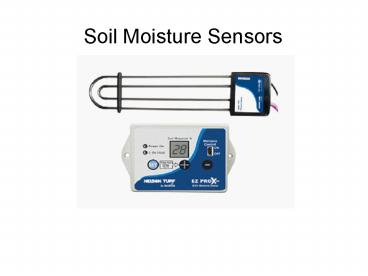Soil Moisture Sensors - PowerPoint PPT Presentation
1 / 15
Title: Soil Moisture Sensors
1
Soil Moisture Sensors
2
Water savings of 46 to 88 reported in
Florida compared to systems with rain
sensors (Lailhacar et al., 2005)
3
Typical installation solenoid
Locate Valve
3 wires
Dry area
4
Atypical installation controller
Connected in controller box
5
Same 3 wires
6
Wiring
7
Moisture sensor Red ?0? Controller hot (color
wire yellow, aqua, or other) Moisture sensor
Black ?0? Valve hot (black) Moisture sensor White
?0? Controller common (white) and Valve Common
(black)
8
Sensor Location
- 4 below ground
- Dry representative location full sun
- Avoid driveways and sidewalks
- gt3 from sprinkler head
- Avoid low areas, bottom of hills
- Avoid high foot traffic
9
Install sensor in root zone
- Install sensor (4-6 deep hole)
- Valve box for connections
- Water and allow it to drain field capacity
- Set at 75 of field capacity
10
Why Soil Moisture Sensors Work
30 field capacity
11
How many zones?
One sensor can be used to control multiple zones
12
Programming the Controller
- 1 hr. irrigation
- 6 _at_ 10 min cycles
- 6 on/off readings
- 0,10,20,30,40,50, or 60 minutes of run time
If moisture is adequate then no irrigation
Moisture adequate after 1,2,3,4, 5 cycles
remainder of cycles are skipped
13
Data Collection
Water Meters
- Zones without Moisture Sensors vs.
- Zones with Moisture Sensors
14
Direct Comparison Method
Advantages - Easy to calculate water savings -
Local government may provide meter
- Disadvantages
- Difficult to find identical zones/fields
- Meters are expensive difficult to install
15
Data Collection
Datalogger with a Pressure Switch
How many irrigation cycles were skipped How much
water was saved
16
Single Zone Method
- Advantages
- Easy to install
- Can be used with a single zone
- Can be used with any zone
- Disadvantages
- Pressure sensor datalogger 500
- Requires calculation
- Ex. Water use (gal./min.) irrigation run time
17
Record Soil Moisture































